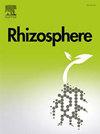Impacts of soil environment on the growth and quality of Cynanchum auriculatum mediated by rhizosphere microorganisms
IF 3.4
3区 生物学
Q1 PLANT SCIENCES
引用次数: 0
Abstract
The growth and quality of Cynanchum auriculatum is profoundly influenced by the soil environment, where multi-year cultivation leading to a reduction in growth potential and an increased susceptibility to diseases. Despite these impacts, there is a lack of comprehensive reports on how the soil environment specifically affects the growth and quality of C. auriculatum. In this study, we collected rhizosphere soil and root samples of C. auriculatum. We determined the soil composition, carbon metabolic capacity, and potential functions using metagenomic techniques, and analyzed the chemical constituents in the roots. We found that microbial metabolic capacity for phenolic acid carbon sources declined significantly in C. auriculatum rhizosphere soils from the third-year compared to the second-year. As planting years increased, the diversity of the rhizosphere soil bacterial community decreased. Bradyrhizobium and Lysobacter were identified as the dominant bacterial genera in the rhizosphere soil of C. auriculatum. The soil environmental factors influencing changes in bacterial and fungal communities in rhizosphere soil were identified as total nitrogen, available nitrogen, available phosphorus, available potassium, alkaline phosphatase, and catalase. These factors influenced the function of metabolic genes in rhizosphere microorganisms, leading to a decrease in metabolic activity and a disruption in the dynamic balance of microorganisms. Our research can provide a theoretical basis for enhancing the rhizosphere soil environment, optimizing management practices, and increasing the productivity and quality of C. auriculatum.
根际微生物介导的土壤环境对木耳生长和品质的影响
金秋木耳的生长和品质深受土壤环境的影响,多年栽培导致其生长潜力降低,对病害的易感性增加。尽管有这些影响,但缺乏关于土壤环境如何具体影响木耳生长和质量的全面报道。在本研究中,我们采集了木耳根际土壤和根样。利用宏基因组技术测定了土壤组成、碳代谢能力和潜在功能,并分析了根系的化学成分。结果表明,从第三年开始,木耳根际土壤酚酸碳源的微生物代谢能力明显下降。随着种植年限的增加,根际土壤细菌群落多样性呈下降趋势。在木耳根际土壤中,缓生根瘤菌和溶菌属是优势菌属。确定了影响根际土壤细菌和真菌群落变化的土壤环境因子为全氮、有效氮、有效磷、有效钾、碱性磷酸酶和过氧化氢酶。这些因素影响了根际微生物代谢基因的功能,导致代谢活性降低,破坏了微生物的动态平衡。本研究可为改善黑木耳根际土壤环境,优化管理措施,提高黑木耳产量和品质提供理论依据。
本文章由计算机程序翻译,如有差异,请以英文原文为准。
求助全文
约1分钟内获得全文
求助全文
来源期刊

Rhizosphere
Agricultural and Biological Sciences-Agronomy and Crop Science
CiteScore
5.70
自引率
8.10%
发文量
155
审稿时长
29 days
期刊介绍:
Rhizosphere aims to advance the frontier of our understanding of plant-soil interactions. Rhizosphere is a multidisciplinary journal that publishes research on the interactions between plant roots, soil organisms, nutrients, and water. Except carbon fixation by photosynthesis, plants obtain all other elements primarily from soil through roots.
We are beginning to understand how communications at the rhizosphere, with soil organisms and other plant species, affect root exudates and nutrient uptake. This rapidly evolving subject utilizes molecular biology and genomic tools, food web or community structure manipulations, high performance liquid chromatography, isotopic analysis, diverse spectroscopic analytics, tomography and other microscopy, complex statistical and modeling tools.
 求助内容:
求助内容: 应助结果提醒方式:
应助结果提醒方式:


